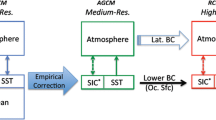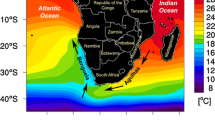Abstract
High-resolution regional climate change simulations have proven to offer an added value compared to available global climate model simulations. However, over many regions of the globe, long-term high-resolution climate change projections are rather sparse. We present a transient high-resolution climate change projection with the regional climate model with the regional climate model REMO over the southern African region, following the SRES A1B emission scenario. The simulation was conducted at 18 km grid spacing for the period from 1960 to 2100, making it to the longest available climate change projection at such a high resolution for the region. In the first part of the study, we focus on the impact of the model setup on the simulated rainfall over the southern African region. In the standard setup, we used the output of the global climate model ECHAM5/MPIOM directly to force REMO. This setup led to a very strong wet bias over the region. Changing it to the double-nesting setup significantly reduced this bias, but a substantial wet bias still persists. The remaining bias could partly be attributed to a warm bias in the SST forcing over the southern Atlantic Ocean. Thus, we applied an SST correction based on the anomaly approach to the data, which led to a further improvement of the rainfall simulation. As the SST bias in the southern Atlantic is a common feature of all global climate models assessed by the IPCC, we recommend the chosen model setup, including the SST correction, as general procedure for dynamical downscaling studies over the southern African region. In the second part, we present the projected spatial and temporal changes of temperature and precipitation, including several rainfall characteristics, over the southern African region. Herby we compare the projections of the high-resolution REMO simulation to those of the forcing regional and global models. We generally find that for temperature the magnitude of the projected changes of the regional model only slightly differs from the GCM projection; however, the spatial patterns are much better resolved in the RCM projections. For precipitation, REMO shows a more intense drying toward the end of the twenty-first century than it is simulated by the global model. This can have a major influence when investigating the impacts of future climate change on a regional or even local scale. In combination with the improved spatial patterns, the application of high-resolution climate change information could therefore improve the results of such applications.
















Similar content being viewed by others
References
Arnell NW, Hudson DA, Jones RG (2003) Climate change scenarios from a regional climate model: estimating change in runoff in southern Africa. Journal of Geophysical Research-Atmospheres 108(D16):4519
Ashfaq M, Skinner CB, Diffenbaugh NS (2010) Influence of SST biases on future climate projections. Climate Dyn. doi:10.1007/s00382-010-0875-2
Christensen J, Christensen O (2007) A summary of the PRUDENCE model projections of changes in European climate by the end of this century. Clim Change 81:7–30
Christensen J, Hewitson BC, Busuioc A, Chen A, Gao X, Held I, Jones R, Kolli R, Kwon W, Laprise V, Mearns L, Menéndez C, Räisänen J, Rinke A, Sarr A, Whetton P (2007) Regional climate projections. In: Solomon S, Qin D, Manning M, Chen Z, Marquis M, Averyt KB, Tignor M, Miller HL (eds) Climate change 2007: the physical science basis. Contribution of working group I to the fourth assessment report of the Intergovernmental Panel on Climate Change. Cambridge University Press, Cambridge
Davies HC (1976) Lateral boundary formulation for multilevel prediction models. Q J R Meteorol Soc 102(432):405–418
Denis B, Laprise R, Caya D (2003) Sensitivity of a regional climate model to the resolution of the lateral boundary condition. Climate Dyn 20:107–126
Engelbrecht FA, McGregor JL, Engelbrecht CJ (2009) Dynamics of the conformal-cubic atmospheric model projected climate-change signal over southern Africa. Int J Climatol 29(7):1013–1033
Fowler HJ, Blenkinsop S, Tebaldi C (2007) Linking climate change modelling to impacts studies: recent advances in downscaling techniques for hydrological modelling. Int J Climatol 27(12):1547–1578
Giorgi F (1990) Simulation of regional climate using a limited area model nested in a general circulation model. J Climate 3(9):941–963
Giorgi F (2006) Regional climate modeling: status and perspectives. J Phys IV 139:101–118
Haensler A, Hagemann S, Jacob D (2010) Dynamical downscaling of ERA40 reanalysis data over southern Africa: added value in the representation of seasonal rainfall characteristics. Int J Climatol. doi:10.1002/joc.2242
Hagemann S (2002) An improved land surface parameter dataset for global and regional climate models. Technical report. Max Planck Institute for Meteorology, Hamburg
Hagemann S, Dümenil Gates L (2003) Improving a subgrid runoff parameterization scheme for climate models by the use of high resolution data derived from satellite observations. Climate Dyn 21(3):349–359
Hagemann S, Goettel H, Jacob D, Lorenz P, Roeckner E (2009) Improved regional scale processes reflected in projected hydrological changes over large European catchments. Climate Dyn 32(6):767–781
Hewitson BC, Crane RG (2006) Consensus between GCM climate change projections with empirical downscaling: precipitation downscaling over South Africa. Int J Climatol 26(10):1315–1337
Hudson D, Jones R (2002) Regional climate model simulations of present-day and future climates of southern Africa. Hadley Centre technical note 39
Jacob D (2001a) A note to the simulation of the annual and inter-annual variability of the water budget over the Baltic Sea drainage basin. Meteorol Atmos Phys 77:61–73
Jacob D (2001b) The role of water vapour in the atmosphere. A short overview from a climate modeller’s point of view. Phys Chem Earth A 26(6–8):523–527
Jacob D, Podzun R (1997) Sensitivity studies with the regional climate model REMO. Meteorol Atmos Phys 63(1–2):119–129
Jacob D, Barring L, Christensen OB, Christensen JH, de Castro M, Deque M, Giorgi F, Hagemann S, Lenderink G, Rockel B, Sanchez E, Schar C, Seneviratne SI, Somot S, van Ulden A, van den Hurk B (2007) An inter-comparison of regional climate models for Europe: model performance in present-day climate. Clim Change 81:31–52
Jacob D, Goettel H, Lorenz P, Kotlarski S, Sieck K (2008) Klimaauswirkungen und Anpassung in Deutschland? Phase 1: Erstellung regionaler Klimaszenarien fuer Deutschland. Umweltbundesamt. http://www.umweltbundesamt.de
Jungclaus J, Keenlyside N, Botzet M, Haak H, Luo J, Latif M, Marotzke J, Mikolajewicz U, Roeckner E (2006) Ocean circulation and tropical variability in the coupled model ECHAM5/MPI-OM. J Climate 19(16):3952–3972
Krug C, Esler K, Hoffman M, Henschel J, Schmiedel U, Jürgens N (2006) North–South cooperation through BIOTA: an interdisciplinary monitoring programme in arid and semi-arid southern Africa. S Afr J Sci 102(5–6):187–190
Laprise R (2008) Regional climate modelling. J Comput Phys 227(7):3641–3666
MacKellar N, Hewitson BC, Tadross M (2007) Namaqualands climate: recent historical changes and future scenarios. J Arid Environ 70(4):604–614
Majewski D (1991) The Europa-Modell of the Deutscher Wetterdienst. In: ECMWF seminar on numerical methods in atmospheric models 2, pp 147–191
Muller A, Reason CJC, Fauchereau N (2008) Extreme rainfall in the Namib Desert during late summer 2006 and influences of regional ocean variability. Int J Climatol 28(8):1061–1070
New M, Lister D, Hulme M, Makin I (2002) A high-resolution data set of surface climate over global land areas. Clim Res 21(1):1–25
Paeth H, Thamm HP (2007) Regional modelling of future African climate north of 15 degrees S including greenhouse warming and land degradation. Clim Change 83(3):401–427
Paeth H, Born K, Girmes R, Podzun R, Jacob D (2009) Regional climate change in tropical and Northern Africa due to greenhouse forcing and land use changes. J Climate 22(1):114–132
Peixoto J, Oort A (1992) Physics of climate. American Institute of Physics, New York, p 520
Reason CJC, Rouault M, Melice JL, Jagadheesha D (2002) Interannual winter rainfall variability in SW South Africa and large scale ocean–atmosphere interactions. Meteorol Atmos Phys 80(1–4):19–29
Rechid D, Raddatz T, Jacob D (2009) Parameterization of snow-free land surface albedo as a function of vegetation phenology based on MODIS data and applied in climate modelling. Theor Appl Climatol 95(3):245–255
Roeckner E, Arpe K, Bengtsson M, Christoph M, Claussen M, Duemenil L, Esch M, Giorgetta M, Schlese U, Schulzweida U (1996) The atmospheric general circulation model ECHAM-4: model description and simulation of present-day climate. Technical report. Max Planck Institute for Meteorology, Hamburg
Roeckner E, Bäuml G, Bonaventura L, Brokopf R, Esch M, Giorgetta M, Hagemann S, Kirchner I, Kornblueh L, Manzini E, Rhodin A, Schlese U, Schulzweida U, Tompkins A (2003) The atmospheric general circulation model ECHAM5. Part I: model description, Max Planck Institute for Meteorology report 349. Max Planck Institute for Meteorology, Hamburg, p 127
Rouault M, Florenchie P, Fauchereau N, Reason CJC (2003) South East tropical Atlantic warm events and southern African rainfall. Geophys Res Lett 30(5):8009
Tadross M, Jack C, Hewitson BC (2005) On RCM-based projections of change in southern African summer climate. Geophys Res Lett 32(23):L23713
Uppala SM, Kållberg PW, Simmons AJ, Andrae U, da Costa BV, Fiorino M, Gibson JK, Haseler J, Hernandez A, Kelly GA, Li X, Onogi K, Saarinen S, Sokka N, Allan RP, Andersson E, Arpe K, Balmaseda MA, Beljaars ACM, van de Berg L, Bidlot J, Bormann N, Caires S, Chevallier F, Dethof A, Dragosavac M, Fisher M, Fuentes M, Hagemann S, Hólm E, Hoskins BJ, Isaksen L, Janssen PAEM, Jenne R, McNally AP, Mahfouf JF, Morcrette JJ, Rayner NA, Saunders RW, Simon P, Sterl A, Trenberth KE, Untch A, Vasiljevic D, Viterbo P, Woollen J (2005) The ERA-40 re-analysis. Q J R Meteorol Soc 131(612):2961–3012
Von Storch H, Zorita E, Cubasch U (1993) Downscaling of global climate-change estimates to regional scales—an application to Iberian rainfall in wintertime. J Climate 6(6):1161–1171
Zhao Y, Camberlin P, Richard Y (2005) Validation of a coupled GCM and projection of summer rainfall change over South Africa, using a statistical downscaling method. Clim Res 28(2):109–122
Acknowledgments
We thank our colleagues from the Terrestrial Hydrology Group and the Regional Climate Modelling Group for the continuing support and discussions on this topic. Further, we thank the Federal Ministry for Education and Research (BMBF, project number 01LC0624B) for funding the work in the BIOTA South project (www.biota-africa.org). Additionally, we would like to thank the German Climate Computing Centre (DKRZ) for providing the high-performance computing facilities.
Author information
Authors and Affiliations
Corresponding author
Rights and permissions
About this article
Cite this article
Haensler, A., Hagemann, S. & Jacob, D. The role of the simulation setup in a long-term high-resolution climate change projection for the southern African region. Theor Appl Climatol 106, 153–169 (2011). https://doi.org/10.1007/s00704-011-0420-1
Received:
Accepted:
Published:
Issue Date:
DOI: https://doi.org/10.1007/s00704-011-0420-1




